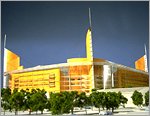 1999 marks the 100th
anniversary of the Highfield Road Stadium - a landmark largely forgotten as everyone
focuses on the planned new stadium in Foleshill.
1999 marks the 100th
anniversary of the Highfield Road Stadium - a landmark largely forgotten as everyone
focuses on the planned new stadium in Foleshill.
The original club, Singers, formed by the cycle workers of the company that bore that
name, in 1883 had their first pitch on Dowells Field just off the Binley Road, between St
George's Road and the railway line. An early player, George Bowers, recalled:
"The pitch was reached by passing through the gate alongside Robinson's Pit, near
Hilly Hollow Fields, later the site of the Gosford Park Hotel."
In 1887, Singers moved to a new enclosed ground called Stoke Road where their pitch lay
between Britannia Street, Wren Street, and Swan Lane, just south of the current stadium.
The committee and supporters erected a grandstand and in the following year, 'stout
fences' around the pitch and a covered press-box.
Extensive house building took place in Hillfields in the 1890's and in 1897, Mr G
Storer purchased the land close to the Stoke Road pitch and this necessitated moving the
goal-posts some 50 yards east to allow for the extension of King Richard Street. This now
left enough room to build the first grandstand accommodating 500 spectators.

In early 1899 - by which time the Singer connection had ceased and the name Coventry
City adopted - preparations began for the laying out of a proper ground, on land from the
Craven Cricket Club.
A row of elm trees was removed (which ran more or less along the present half-way
line), the pitch was levelled and a 12-row stand, holding 2000 spectators was built on the
King Richard Street side, where today’s Main Stand is. On 9 September City kicked-off
the 1899-1900 season at Highfield Road with a 1-0 win over Shrewsbury in front of 3000
people.
The correspondent of the Coventry Reporter described the scene:
"As one enters the ground from Highfield Road, the eye encounters the grand new
stand on the opposite side of the enclosure. It is a gigantic wooden structure, roofed
with corrugated iron, and is coloured chocolate and light blue. Indeed it presents a fine
picture and is an ornament of which the committee might well be proud."
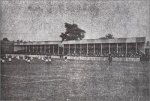
HIGHFIELD ROAD 1909
[click photo to enlarge]
|
In 1910 the proceeds of the first decent Cup
run financed the construction of a new barrel-roofed main stand on the north side at a
cost of £1,200. The club struggled thereafter and were fortunate to be voted into the
Football League in 1919.
During the 1920’s there always seemed to be a
financial crisis and ground improvements were minimal. In 1922 the Kop (or East Terrace)
later described as a steep, scarred and totally shapeless mess, was built up using waste
concrete from the relaying of the city's tram track.
The West Terrace was covered five years later by a roof
purchased for £2,200 from Twickenham Rugby ground. It provided cover for 11,000
spectators and during construction it was found that the pitch fell seven feet from corner
to corner, a fault not rectified until 1963.

COVENTRY CITY v TORQUAY
HIGHFIELD ROAD, 1936
[click photo to enlarge]
|
In 1936, to celebrate City's promotion back
to Division 2 and with gates regularly topping 25,000, the 'rotting planks' of the
original 1899 stand were demolished to make way for a new main stand at a cost of
£14,000. In November of that year the club purchased the freehold of the ground from the
Mercers' Company for £20,000, thanks to a loan from Sir John Siddeley, chairman of the
car-makers Armstrong-Siddeley.
The additional lattice-board standing extension to the Kop,
known as the 'Crows Nest', was added in 1938, and in 1939 a canopy extension was built on
to the main stand. Highfield Road could now accommodate over 40,000 spectators as was
demonstrated on a number of occasions before the outbreak of war.
Amazingly, most of the Highfield Road ground survived the
heavy air-raids of November 1940, although three direct hits did destroy the pitch.
However by 1942 the playing surface had been sufficiently patched up to stage matches
again.
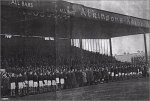
COVENTRY CITY v WEST HAM
HIGHFIELD ROAD, 1952
[click photo to enlarge]
|
City were relegated in 1952 and, like the
rubble strewn streets around the stadium, City face a major re-building task. In October
1953 basic floodlights were installed on poles, and were first used for a friendly game
against Queen of the South.
In 1957 the originals were sold to Crewe and an improved
set of lights made their debut for a game against Third Lanark. The Supporters' Club paid
for the new lights at a cost of £15,000 and the pylons were still being used in 1991.
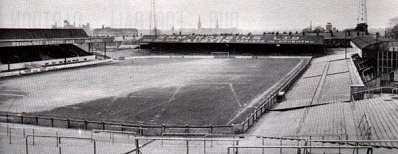
HIGHFIELD ROAD 1962
- taken from the Spion Kop, with the Atkinsons Ales stand,
built in 1910 and demolished in 1964
The Sky Blue era under Derrick Robins and Jimmy Hill sparked a massive ground
improvement programme, ably carried out by Robins’ company, Banbury Buildings. The
rebirth began in 1963 with the replacement, section by section, of the Thackhall Street
stand, using innovative prefabricated units and a distinctive vaulted roof. The new
‘Sky Blue Stand’, which cost £120,000, was fully operational for the start of
1964-65 season as City re-entered Division 2 after a twelve year gap.
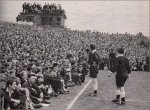
COVENTRY CITY v WOLVES
RECORD CROWDS, 1967
[click photo to enlarge]
|
Two years later and the club won promotion
to Division 1 for the first time in their history and Highfield Road saw a record crowd of
51,455 for the crucial match against Wolves.
That close season, the old covered terrace, home to the Sky
Blue ‘choir’, was demolished and replaced by the double-decker West Stand -
3,200 seats on top of terracing. That first season in Division 1 saw record crowds at the
stadium and the final average was an incredible 34,715.
[CHECK THE FULL LIST OF RECORD ATTENDANCES AT HIGHFIELD ROAD]

THE FIRE IN THE MAIN STAND, 16 March 1968
[click photo to enlarge]
|
On 16 March 1968, the Main Stand was gutted
by fire and with it the Second Division Championship Trophy. The stand was rebuilt almost
immediately at a cost of £150,000, and was completed in time for the start of the next
season, although the first two home games were postponed.
The third new stand in four years made Highfield Road
arguably the most modern stadium in the land. Plans were drawn up for a fourth new stand,
to replace the Kop and to include a sports complex, but the club’s fading gloss meant
that this was to be a pipe-dream.
In 1973, defects were discovered in the roof of the Sky
Blue Stand and the vaulted section was replaced by a flat roof, then, early in 1983, part
of the replacement roof collapsed in gales but the damage was quickly patched up.
In 1981, the controversial decision was taken to convert
Highfield Road into England’s first all-seater stadium and 8,000 extra seats were
installed at a cost £400,000 reducing the capacity, at a stroke, from 36,500 to 20,600.
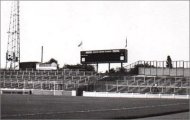
HIGHFIELD ROAD 1980
PRE ALL-SEATER
[click photo to enlarge] |
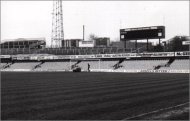
HIGHFIELD ROAD 1981
ALL-SEATER
[click photo to enlarge] |
This unanimously unpopular decision was
intended, amongst other things, to deter hooliganism but instead it alienated the fans
and, with every game all-ticket, it became harder for fans to attend. Attendances dropped
as performances on the pitch deteriorated and the failed experiment accelerated Jimmy
Hill’s resignation as chairman.
The seats were ripped out of the Kop in 1985 and the end
partially rebuilt to allow a better view. Following the 'Taylor Report’ in 1990 City,
with almost 18,000 seats out of a capacity of 26,000, were well placed to meet the
report’s recommendations that all top division grounds should be all-seater by August
1994. Work started in the summer of 1993 on the new East Stand and the team played
it’s home games to a three sided stadium for one season whilst the new stand rose
from the wreck of the flattened kop.
With the East Stand costing £4.3 million, the majority of
which came from the Football Trust and the brewers, Mitchell and Butlers, and the new
roofs on the Main Stand and Sky Blue Stand, over £7 million has been spent on the ground
this decade. But at the end of the 1990’s the club have a new state-of-the-art
stadium to look forward to in the new millenium.
[PHOTOGRAPHS FROM VARIOUS SOURCES -
SUPPLIED BY JIM BROWN]

